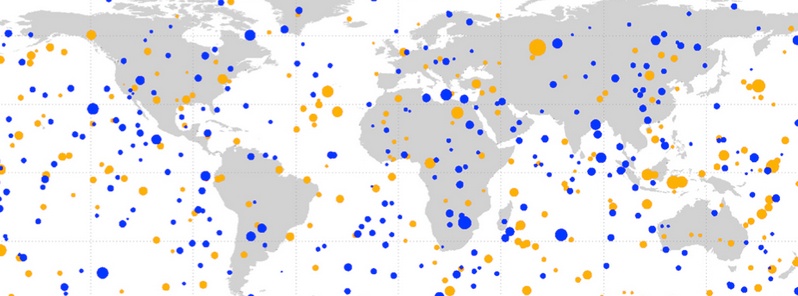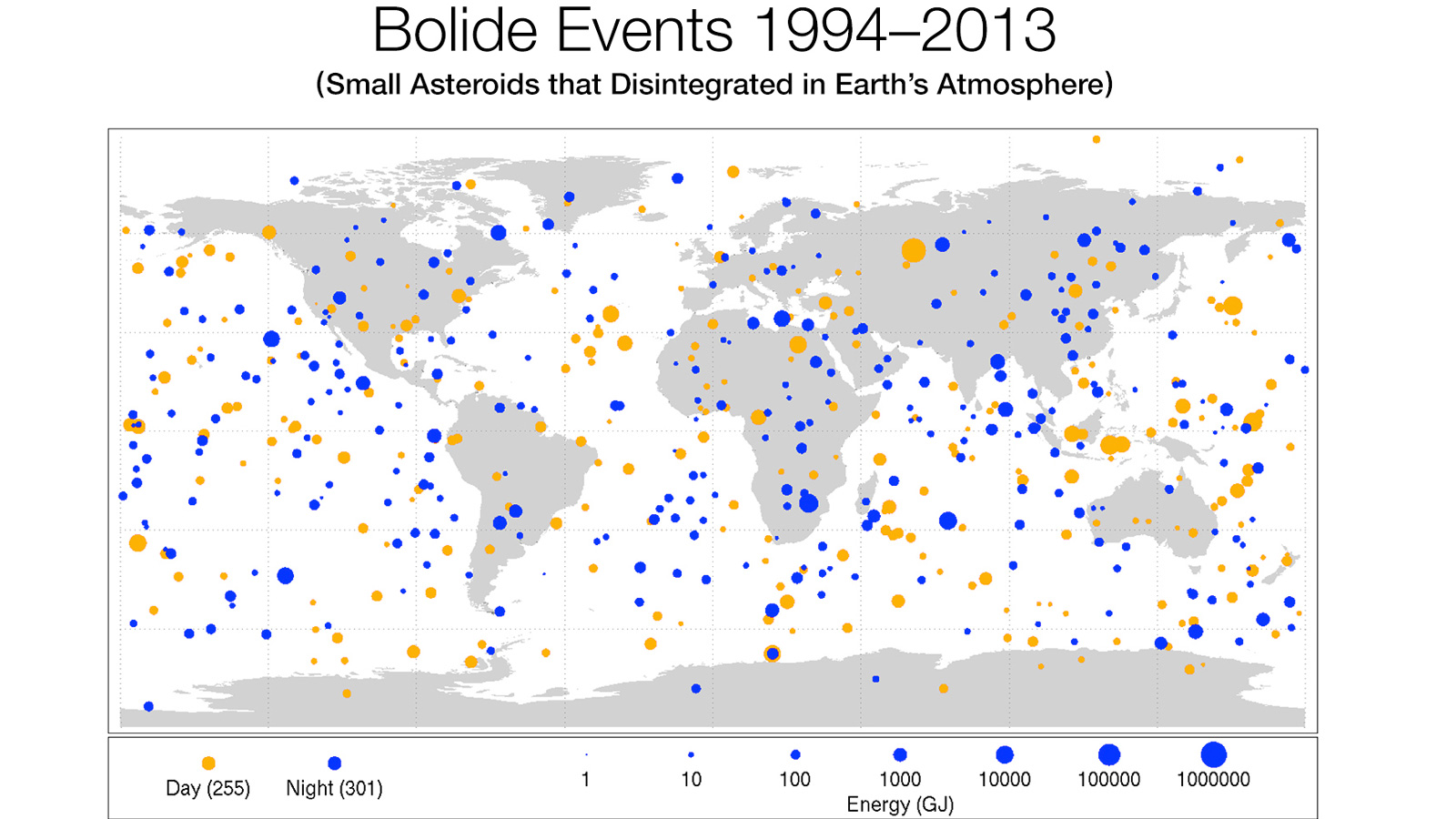Newly released map shows frequency of small asteroid impacts

A map released yesterday by NASA's Near Earth Object (NEO) Observation Program reveals that small asteroids frequently enter and disintegrate in the Earth's atmosphere with random distribution around the globe. Released to the scientific community, the map visualizes data gathered by U.S. government sensors from 1994 to 2013.
The data indicate that Earth's atmosphere was impacted by small asteroids, resulting in a bolide (or fireball), on 556 separate occasions in a 20-year period. Almost all asteroids of this size disintegrate in the atmosphere and are usually harmless.
The largest impact recorded during this 20-year interval was the Chelyabinsk event (440 000 – 500 000 tons of TNT) recorded over central Russia on February 15, 2013. This small asteroid that exploded in the atmosphere over Russia was about 20 meters in size before it hit the Earth. While that impact focused public attention on the potential hazards of NEO impacts with Earth, space scientists have long known that such events are just a part of Earth's geologic history.
NASA's NEO Observations Program finds, tracks, and characterizes asteroids whose orbits bring them within approximately 50 million kilometers (31 million miles) of Earth's orbit about the Sun.

This diagram maps the data gathered from 1994-2013 on small asteroids impacting Earth's atmosphere to create very bright meteors, technically called "bolides" and commonly referred to as "fireballs". Sizes of red dots (daytime impacts) and blue dots (nighttime impacts) are proportional to the optical radiated energy of impacts measured in billions of Joules (GJ) of energy, and show the location of impacts from objects about 1 meter (3 feet) to almost 20 meters (60 feet) in size. Image credit: Planetary Science
"We now know that Earth's atmosphere does a great job of protecting Earth from small asteroids," said NASA NEO Observations Program Executive Lindley Johnson. The new data will be extrapolated to estimate more precisely the frequency of impacts by asteroids large enough to cause ground damage. "How big is the population of larger asteroids we really need to worry about? We need to better understand that," Johnson said.
While the new data emphasize that small asteroid impacts with Earth are not unusual, the risk of future impacts is not to be taken lightly. "The aim is to find potentially hazardous asteroids before they find us," said Donald Yeomans, manager of NASA's NEO Program Office at the Jet Propulsion Laboratory (JPL).
The NEO Observations Program already has identified more than 96 percent of the estimated population of nearly one thousand one-kilometer or larger sized asteroids, JPL said.
The Program's current objective is to identify 90 percent or more of the far more numerous NEOs larger than 140-meters in diameter. It is estimated they may be as much as 25 times more numerous than 1 kilometer asteroids.
Every day, Earth is bombarded with more than 100 tons of dust and sand-sized particles from space. About once a year, an automobile-sized asteroid hits Earth's atmosphere, creating a spectacular fireball (bolide) event as the friction of the Earth's atmosphere causes them to disintegrate – sometimes explosively.
Studies of Earth's history indicate that about once every 5 000 years or so on average an object the size of a football field hits Earth and causes significant damage. Once every few million years on average an object large enough to cause regional or global disaster impacts Earth. Impact craters on Earth, the Moon and other planetary bodies are evidence of these occurrences.
Meteor Crater near Winslow, Arizona, is evidence of the impact with Earth's surface of a 50-meter asteroid about 50 000 years ago. Impact of the metal-rich object released energy equivalent to a 10 megaton explosion and formed a 1.2 kilometer-diameter crater. Scientists have identified several dozen impact craters in North America alone, most masked by erosion and vegetation.
Scientific assessments of the risk of, as well as the hazards posed by, future asteroid impacts with Earth vary. In a 2013 paper published in Nature, Peter Brown and his colleagues reported that "telescopic surveys have only discovered about 500 near-Earth asteroids that are 10-20 meters in diameter (comparable to the Chelyabinsk asteroid) of an estimated near-Earth asteroid population of around 2 x 10 7 [20 million], implying that a significant impactor population at these sizes could be present but not yet cataloged in the discovered near-Earth asteroid population."
"These newly released data will help NEO scientists construct a more complete picture of the frequency and scope of asteroid impacts with Earth," Johnson said.
Finding and characterizing hazardous asteroids to protect our home planet is a high priority for NASA. It is one of the reasons NASA has increased by a factor of 10 investments in asteroid detection, characterization and mitigation activities over the last five years. In addition, NASA has aggressively developed strategies and plans with its partners in the U.S. and abroad to detect, track and characterize NEOs. These activities also will help identify NEOs that might pose a risk of Earth impact, and further help inform developing options for planetary defense.
The public can help participate in the hunt for potentially hazardous Near Earth Objects through the Asteroid Grand Challenge, which aims to create a plan to find all asteroid threats to human populations and know what to do about them. NASA is also pursuing an Asteroid Redirect Mission (ARM) which will identify, redirect and send astronauts to explore an asteroid. Among its many exploration goals, the mission could demonstrate basic planetary defense techniques for asteroid deflection.
For details about ARM, and the Asteroid Grand Challenge, visit: http://www.nasa.gov/asteroidinitiative
Source: JPL
Featured image credit: Planetary Science

Commenting rules and guidelines
We value the thoughts and opinions of our readers and welcome healthy discussions on our website. In order to maintain a respectful and positive community, we ask that all commenters follow these rules.